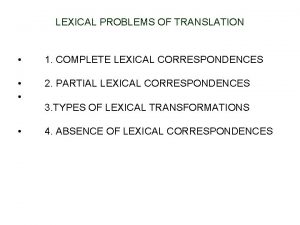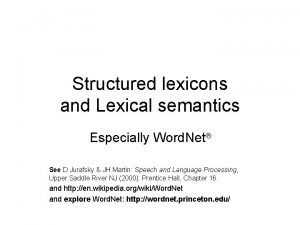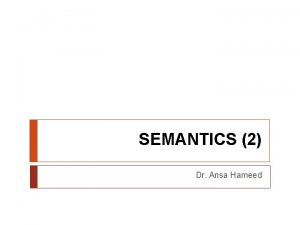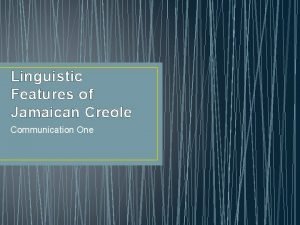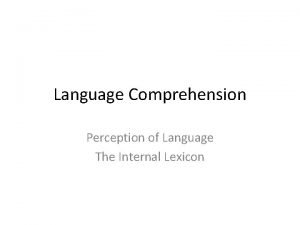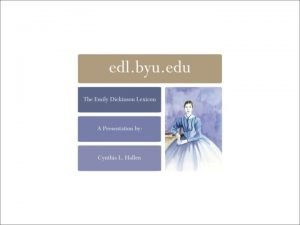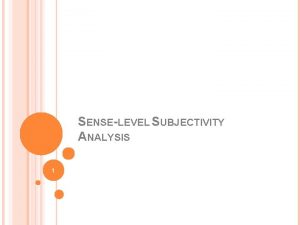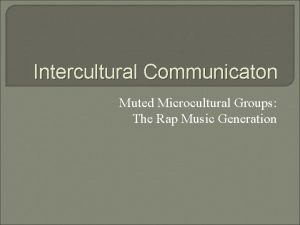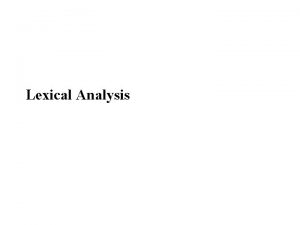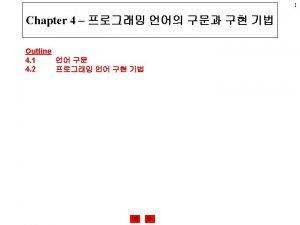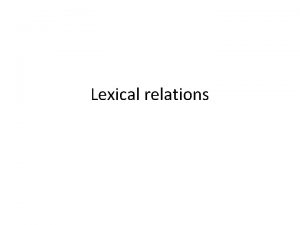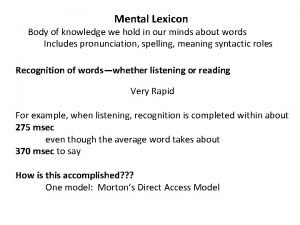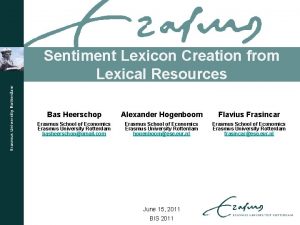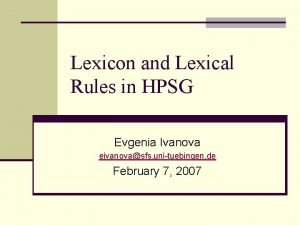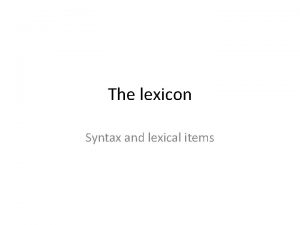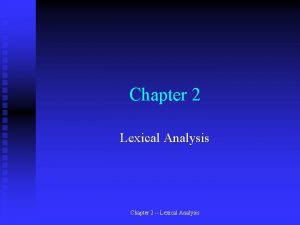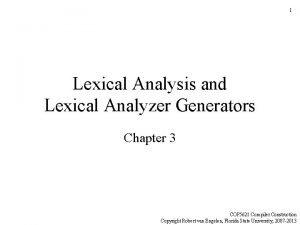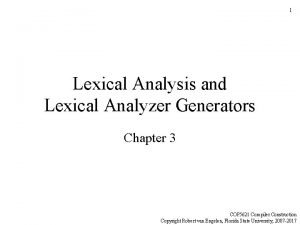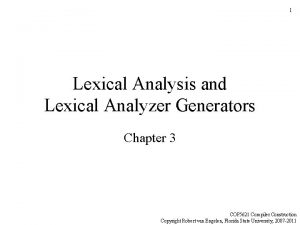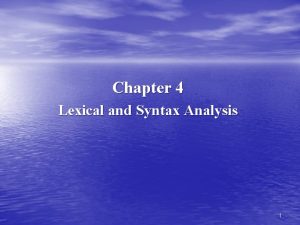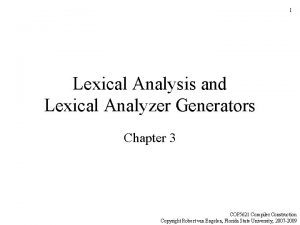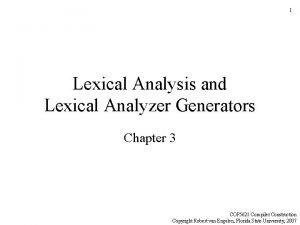Chapter 5 Mental lexicon 2019 2 Lexical Knowledge


















- Slides: 18

Chapter 5 Mental lexicon 2019년 2학기

차 례 • Lexical Knowledge & Properties (어휘적 지식 과 특성) Chapter Lexicon 5 • Traditional models and modules (전통적인 읽 기 모형언어만의 모듈적 처리) – Logogen (로고젠), Frost – Dual Route model, 이중경로 – Phonological Recoding 음운재부호화 • Experimental Evidence of models, 음운재부호 화의 실험증거와 이중경로의 실험증거

Mental Lexicon (심성어휘집) • Where words are strored; All information including phonological & orthographic Chapter 5 information; When a word is activated and accessed to the lexicon, it is called lexical access. 어휘들이 저장되어 있는 장소; 의미뿐 만 아니라 단어의 형태정보와 음운정보등을 포함한다. 단어를 보고 어휘집 을 활성화하는 일련의 단계를 어휘 접근 (Lexical Access) 라고 한다. 완전하게 의미를 활성화하는 것을 포함할지 아니면 해당 어휘 주소를 찾아낸 단계 • When “mother” is seen, please state what information is activated. “엄마” 라는 단어를 보면 어떤 정보가 활성화 되는지 열거… • Meaning is activated after the lexical access. 어휘 접근 후 의미 발생

How to measure? popular lexical tasks • Measuring RT; emphasizing speed and accuracy • 1. Naming task: name the STM appear on the screen; most easiest task; It does not guarantee the lexical access Chapter 5 • 2. Lexical task: decide the lexicality of the STM; lexical access; the performance is affected by the types of Nonwords. E. g. , when the NW is very unfamiliar (i. e. , zwxqt), the processing would not reflect real word processing. • 3. Semantic Categorizatio task; decide on whether the STM is belong to a certain categoy; The type of category can affect the performance (subject can predict); this task reflect “postlexical” processings • 1. 명명과제: 가장 간단이 장점; 그러나 어휘집 접근을 보장 못함 • 2. 어휘판단과제 : 어휘집 접근보장; 비단어의 종류에 따라 영향 받을수 (예: 비단어가 단어와 유사성이 떨어질때 zwxqt (충분한 처리가 안됨)) • 3. 어휘범주판단과제 : 어휘집을 넘어 의미로; 제시되는 범주에 따라 영향을 받을 수 (flower vs. Plant -> 피험자가 예측)


Morton (1969) logogen model: concept of threshold Chapter 5

Forster (1976, 2008; 수정) Search model Store by each information type; ; Words are positioned by word frequency; 각각의 속성별로 저장된 어휘집의 개념 제안 ; 빈도순 저장이 특 징 Chapter 5

Dual – Route 모형 (Coltheart , 2002) Reading & Speaking are all combined; Othorgraphic (Visual) route is stronger than the phonological route Chapter 5

Dual – Route 모형 (Coltheart , 2002) 1. Word regularity effect 단어규칙성효과: Best is faster than cafe; only low frequency has the regularity effect, supporting the dual route model; best 와 café 규칙성효과가 저빈도 단어에서만 나타남 Chapter 5 2. No phonological masked priming; 음운 점화 과제: 나오지 않음 예: TOWED -> toad vs. TODS -> toad; TODS 한글의 예 TOUD -> toad vs. 3. Circumstantial evidence of childe language acquisition; 아 동의 언어습득과정에 대한 정황증거 4. Orthographic Depth; Different types of processing by different orthographies.

Phonological Recoding Hypothesis (Lukatela et al. 2002 Chapter 5

Evidence for the phonological recoding 1. Pseudohomophone performance 동음비단어 판단 수행: BRANE vs. BRANS Chapter 5 2. Phonological priming 음운 점화 과제: 다양한 방식으로 가 능 예: TOWED -> toad vs. TODS -> toad; TODS 한글의 예 TOUD -> toad vs. 3. Semantic categorization: The role of phonology in semantic category judgment 의미의 범주 판단에서 음운의 역할 Van Orden: ROWS -- Category of flower, More errors for the homophone error발생이나 RT의 신속성 How about “ROUZ”? More errors for the pseudohomophone and the RT is as fast as real word (e. g. , rose). 잘못판단하거나, “RT Yes의 시간이 ROSE 와 유사하다는데 “ 음운의 개입이 매우 신속함을 시사

Backgrouds for two models Dual Route model Phonological Recoding Visual route is the main Only phonological route in lexical access direct connection is economical Regular connection bt. letter and phoneme Processing is sensitive to frequency and lexicality No modulation by frequency and lexicality Phonological is calculated after the lexical access Calculated by GPC (graphemephoneme correspondency) rule Phonological route is bypassed as No bypass, just become implicit we grow older Two routes are existed; relative role is different

Main variables in lexical access • Word frequnecy 단어빈도 Phoneme detection of “b” is slower when it is included in the low frequency word than high frequency word. 음소 탐지 과제 (Phoneme detection task)에 서 특정 음소 (예: b)의 탐지가 저빈도 단어에서 포함될 때에 고빈도 단어에 포함될 떄보다 오래 걸린다. • Chapter 5 심리적 기제 Word Lengh 단어길이 Length is the second strong variable after freuqency. 10 -30 percent of variance; various types of lengh (orthographic, phonological) 단어의 길이 가 길어질수록 오래 걸림; 빈도 다음으로 강력한 변인으로 알려짐 변량의 10 -30 퍼센트 차지. 표기적 길이 음운적 길이 – . • Neighborhood size 이웃단어 Lust 와 café. Korean example: 사랑 과 사령 사랑과 사격 (syllable neighbor), 국민 과 궁핍 (phonological syllable neighbor) • 국민, 국가, 국정, 국사 와 국밥 (Morphological neibor) • Orthographic neighborhood and phonological neighborhood 표기이 웃단어와 음운이웃단어

The role of morphology • Monomorpemic words are faster than multi-morphemic words • Is the morpheme a unit of lexical access? (derivative “decision” & inflection “decided”) 형태소 분리 처리 여부 ? (파생어 decision 과 굴절어 decided 분리 여부) • Rastle: When the orthographic form is just like morpheme, it can act like the morpheme in lexical access. corner -> corn 표기형태적 요소만 있으 면 점화가능: corner -> corn : 형태소적 의미가 활성화를 일으키는 것이 아니라 형태소처럼 생겨있으면 영향 을 준다는 것 시사 • Korean case: it was difficult to find the morphological priming; Possibly due to Sino-Korean (each syllable came from Chinese morphemic roots. ) 한글의 경우: 국민, 국정, 국사 … 영향 줄 개연성이 있으나 찾지 못함 국민 -> 국정 국밥 ->국정 비교 아마도 한문적 의미가 복수인 관계로 활성화를 일으키지 않는 것으로 보임 *고유어의 형태소 처리: 눈꽃, 우체통; 형태소의 위치와 문제


3 field priming with different size and font

TL in monosyllabic and dysyllabic words TL word prime TL NW prime Condition RT % ER Identity TL priming Control 658 721 723 0. 12 0. 13 668 718 704 0. 12 0. 14 Condition s Identity RTs Transposed Controls Difference 510 Error rates 0. 01 1 st syllable TL 2 nd syllable TL 559 560 -1 554 556 -2 0. 04 0. 02 Controls 0. 03 0. 02 Difference 0. 01 0 Note. TL = the prime with the transposed letters of onset and coda in the syllable of a word Transposed

Korean Word Recognition Model Feature Extraction | O / Letter Extraction ㅁ ㄱ ㅇ Orthographic Body Syllable Extraction 머/ㄱ 어/ㅆ 고 “먹” / “었” / “고” ㅓ ㅗ ㅓ ㅅ Lexical Access & Lexical Competition 예 먹 먹고 -> 먹+고 먹었고 -> 먹었+고 먹었니? -> 먹었+ㄴ 학교에 -> 학교+에 학교운동장에->학교운동장+에 교 학 그 고 니 었 Finish 사 Lexical Selection 강 먹었고 원 생 Finish 의 시 간 18
 Mental lexicon
Mental lexicon Lexical problems
Lexical problems Mental health and mental illness chapter 20
Mental health and mental illness chapter 20 Lexicon semantics
Lexicon semantics Meronymy
Meronymy Bi-rad 4 suspicious abnormality
Bi-rad 4 suspicious abnormality Creole lexicon
Creole lexicon Internal lexicon
Internal lexicon Emily dickinson noah webster
Emily dickinson noah webster Mpqa subjectivity lexicon
Mpqa subjectivity lexicon Microcultural groups
Microcultural groups Open lexicon
Open lexicon Mental health coping skills jeopardy
Mental health coping skills jeopardy What is shared knowledge
What is shared knowledge Knowledge shared is knowledge squared
Knowledge shared is knowledge squared Knowledge shared is knowledge multiplied
Knowledge shared is knowledge multiplied Knowledge creation and knowledge architecture
Knowledge creation and knowledge architecture Contoh shallow knowledge dan deep knowledge
Contoh shallow knowledge dan deep knowledge A posteriori
A posteriori

